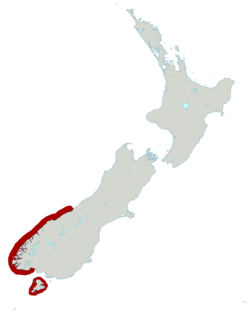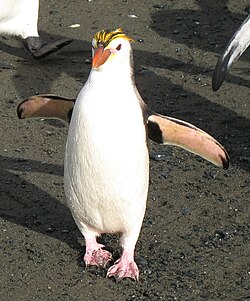Top Qs
Timeline
Chat
Perspective
Crested penguin
Genus of birds From Wikipedia, the free encyclopedia
Remove ads
Eudyptes (from Ancient Greek εὖ (eû), meaning "true, well", and δύπτης (dúptes), meaning "diver", and thus, "true diver") is a genus of penguins whose members are collectively called crested penguins.[2] The exact number of species in the genus varies between four and eight depending on the authority, and a Chatham Islands species became extinct in recent centuries. All are black and white penguins with yellow crests, red bills and eyes, and are found on Subantarctic islands in the world's southern oceans. All lay two eggs, but raise only one young per breeding season; the first egg laid is substantially smaller than the second.
Remove ads
Taxonomy
Summarize
Perspective
The genus Eudyptes was introduced by the French ornithologist Louis Pierre Vieillot in 1816;[3] the name is derived from the Ancient Greek words eu meaning "fine", and dyptes meaning "diver".[4] The type species was designated as the western rockhopper penguin by George Robert Gray in 1840.[5][6]
The genus contains eight exant species:[7]
- Macaroni penguin, Eudyptes chrysolophus
- Royal penguin, Eudyptes schlegeli
- Northern rockhopper penguin, Eudyptes moseleyi (formerly a subspecies of E. chrysocome)
- Eastern rockhopper penguin, Eudyptes filholi (formerly a subspecies of E. chrysocome)
- Western rockhopper penguin, Eudyptes chrysocome (Formerly southern rockhopper penguin before split)
- Fiordland penguin, Eudyptes pachyrhynchus
- Snares penguin, Eudyptes robustus
- Erect-crested penguin, Eudyptes sclateri
Also a fossil species:
- Chatham penguin, Eudyptes warhami (extinct)
Eudyptes warhami is known only from subfossil bones, and became extinct shortly following human colonisation of the Chatham Islands. This genetically-distinct species was relatively large, with a thin, slim and low bill.
Evolution

Mitochondrial and nuclear DNA evidence suggests that the crested penguins split from the ancestors of their closest living relative, the yellow-eyed penguin, in the mid-Miocene around 15 million years ago, before splitting into separate species around 8 million years ago in the late Miocene.[8]
A fossil penguin genus, Madrynornis, has been identified as the closest known relative of the crested penguins. Found in late Miocene deposits dated to about 10 million years ago, it must have separated from the crested penguins around 12 million years ago. Given that the head ornamentation by yellow filoplumes seems plesiomorphic for the Eudyptes-Megadyptes lineage, Madrynornis probably had them too.[citation needed]
Extant Species
Remove ads
Description
The crested penguins are all similar in appearance, having sharply delineated black and white plumage with red beaks and prominent yellow crests. Their calls are more complex than those of other species, with several phrases of differing lengths.[9] The royal penguin (mostly) has a white face, while other species have black faces.
Breeding
Summarize
Perspective
Crested penguins breed on Subantarctic islands in the southern reaches of the world's oceans; the greatest diversity occurring around New Zealand and surrounding islands. Their breeding displays and behaviours are generally more complex than other penguin species.[10] Both male and female parents take shifts incubating eggs and young.[11]
Crested penguins lay two eggs, but almost always raise only one young successfully. All species exhibit the odd phenomenon of egg-size dimorphism in breeding; the first egg (or A-egg) laid is substantially smaller than the second egg (B-egg). This is most extreme in the macaroni penguin, where the first egg averages only 60% the size of the second.[12] The reason for this remains unknown, although several theories have been proposed. British ornithologist David Lack theorized that the genus was evolving toward the laying of a one-egg clutch.[13] Experiments with egg substitution have shown that A-eggs can produce viable chicks that were only 7% lighter at time of fledging.[14] Physiologically, the first egg is smaller because it develops while the mother is still at sea swimming and thus has less energy to invest in the egg.[15]
Recently, brooding royal and erect-crested penguins have been reported[by whom?] to tip the smaller eggs out as the second is laid.
References
External links
Wikiwand - on
Seamless Wikipedia browsing. On steroids.
Remove ads















